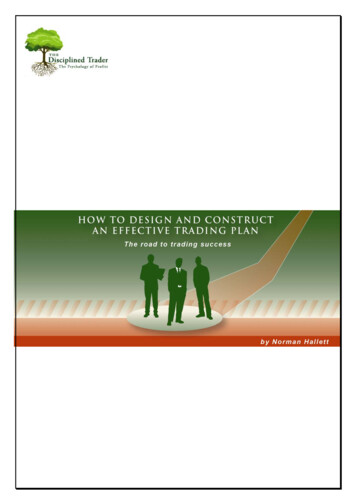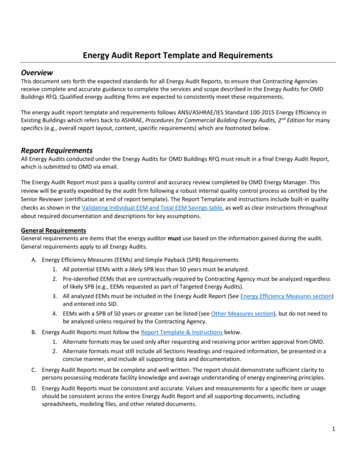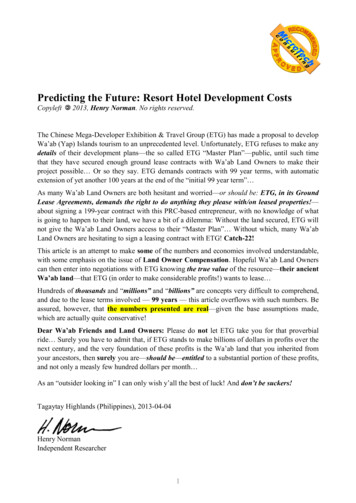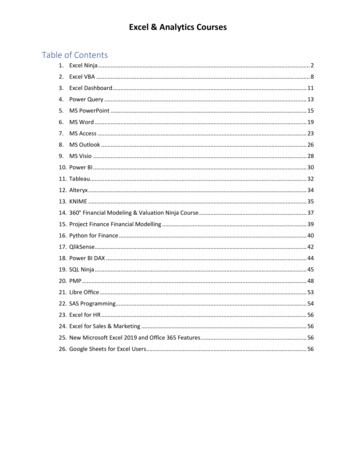
Transcription
Table of ContentsChapter 1: Introduction 4How to define your trading “destination” 5What is a Successful Trader? 6Chapter 2: The Strategic Philosophy of Trading 8Identifying High Probability Trades 9Risk-Reward 10The Trading System 10Chapter 3: Developing your Personal Profile 12Personal Goals 13Trading capital and financial objectives 15Establishing your risk profile 17Personal Risk Profile questionnaire 18Identifying your Strengths and Weaknesses 19Attitude 20Imagining your worst trading nightmare 20Writing out your trading premise 21Example trading premise 21Chapter 4: Developing an Effective Trading Strategy 22Full or part time trading? 22Round-the-clock trading 23Trading Style 23Example of a Position Trade 22Example of a Day Trade 23Example of Scalping 23Example of Swing Trading 24Chapter 5: Trading System and Trading Rules 26Fundamental Analysis 27The Balance Sheet 27The current ratio 28The Operating Statement 29Price-Earnings ratio (P/E) 29How to estimate the future value of stock shares using P/E Multiple 29Return on Investment (ROI) or Return on Equity (ROE) 30Quarterly and Annual Reports 30Fundamentals for other types of investment 31Technical Analysis 31How to Design and Construct An Effective Trading Plan2
Charting 31Moving Averages 32Simple moving average (SMA) 32Trend Identification/Confirmation 34Support and Resistance Levels 35Moving Average Convergence Divergence – MACD 35On Balance Volume 36Bollinger Bands 36Relative Strength Index 37Divergence 37Selection Filters 38Sample Trade Selection 39The Importance of Paper Trading 41Trading System, Trading Rules and the Trading Plan 42Example of Trading Rules 43Chapter 6: Establishing a Trading Schedule 45U.S. National Exchanges 45Regional U.S. Exchanges 46Canada 46Europe 46U.K. 47Japan 47Chapter 7: Setting up a Trading Journal 49The Trading Journal-your best friend 50Key Questions to ask yourself 50When to make Journal entries 51Example of a Trading Journal 52Chapter 8: Testing your Trading System 53Pros and Cons of Paper Trading 54Chapter 9: The Emotional Aspects of Trading 55Holistic Trading 56Characteristics of a Successful Trader 58Chapter 10: The Power of Objectivity 62Give and receive 64Chapter 11: Putting it all Together-a Sample Trading Plan 65In Closing 71How to Design and Construct An Effective Trading Plan3
Chapter 1: IntroductionYou haven’t thought much about it other than you want to take a vacation. You grab the keys toyour car and head out on the highway. Hours pass and you watch the scenery change frommetropolitan landscape to bucolic greenery. You feel the tension leave your body. Darkness fallsand you pull into a motel for the night. After getting settled in you room, you turn on the television,kick off your shoes and flop on the bed. You reach for the phone to call a friend to tell them aboutyour trip.Your friend picks up the phone and hears the excitement in your voice. But then he asks a questionthat shocks you and you sit up straight in your bed. “Where are you headed”, your friend asks. Thisseemingly innocuous question hits you like a slap across the face. It’s hard to believe but you haveno idea. You look around the room and realize that you haven’t packed any clothes. No toothbrush .nothing. You suddenly feel disoriented and can’t believe what you have done. You feel sostupid that you blurt out, “the Keys”. You slowly replace the receiver while you friend is stilltalking on the other end. Are you in the Twilight Zone?Needless to say, this absurd scenario is highly unlikely because nobody would ever take a tripwithout planning first. You know, decide the destination, check the route, make advancedreservations and that sort of stuff. Nobody would just takeoff without planning.But that’s exactly what takes place with most new traders. No defined destination, no road map, noidea of how to get there; “there” meaning making money by trading. What are the chances of beingsuccessful in your journey if you don’t even know such basic things as where you are going? It istruly unbelievable how many traders bite the dust (it’s estimated that about 90% of all beginningtraders are out of trading within several months) mainly because they lack the proper preparation.Apparently, to most new traders success appears as just a simple matter of choosing the properdirection of movement. That’s like believing that a band aide will cure any disease. Indeed, tradingis a much more complicated undertaking and requires extensive preparation. If it were so easy tomake money, everybody would be doing it. Being a successful trader is not a matter of luck or evenskill, it is a matter of proper preparation.And that is what this book is all about.How to Design and Construct An Effective Trading Plan4
If you read this book and follow its advice, your chances of becoming a successful trader will begreatly improved.Why is that so?Because successful traders say so.None of the ideas put forth in this book are revolutionary or “leading edge”. What will be presentedis a proven formula used by most professional traders. The methods are based upon the mentoringguided training format that most professional trading companies and departments use to train theirnew traders. The reader will be led step-by-step through the same type of training program thatmost pros went through and use to this day. It’s not brain surgery or rocket science. But it’s onething is to read about it and another to live it. That, dear reader is up to you.How to define your trading “destination”One of the first things you need to do when planning your journey to becoming a successful traderis to define what “successful” means. Does it mean becoming a millionaire? Does it mean you canmake a living by becoming a trader and working out of your laptop and cell phone? Does it meanthat you can provide an opportunity to earn extra income apart from your regular job? Does it meanyou can live in an area you desire without the need of finding a “real job”?Yes, success means different things to different people but one thing in common with trading is thatto stay in business as a trader, you have to win more than you lose. In other words, you must make aprofit or eventually you will come to the realization that you are no match for the market. So, let’stake it for granted that making a profit is a major goal in trading.But that’s not enough. You need to be much more specific. A goal must be relevant and realistic.So first, you must identify why you want to trade before you can define what your picture ofsuccess will look like.For example, if you want to be independent and live where you want, you must first decide howmuch income you will need to lead the lifestyle you want. If you need 6,000 per month for livingexpenses, you can quickly see if your trading capital can provide you with that level of income. Ifyou have trading capital of 100,000 (not including savings of at least 6 months living expenses),you would need to generate an annual return of 72% or 6% per month return on your trading.If you just want to make extra money for a vacation, home, or other material item, first decide howmuch that material item will cost in the future and use that as your goal. For example, if you wantthe down payment for a new home, you establish that amount and then look at what amount youhave to invest. If you need to have a 50,000 down payment on that dream home and you plan toinvest 10,000, if you can produce a 40% annual return (3.33% per month) you could accumulatethe 50,000 in about 41/2 years discounted for inflation and not including taxes.If you just want to earn enough for that yearly vacation, find out how much it costs and figure outwhat sort of return on investment (ROI) you will need to get there. For example, if you want totravel to Peru and spend one month mountain climbing in the Andes, you estimate that it will costabout 7,000. If you have 20,000 to invest, a 40% annual (3.33% per month) ROI would return theamount you would need in about 12 months-not including taxes. Sounds simple, doesn’t it! AsHow to Design and Construct An Effective Trading Plan5
always, however, the devil is in the details. But to have a realistic goal, you first need to accuratelydescribe your goals .your destination.A trader must also develop a clearly defined process to identify what is feasible and desirable foreach individual trader. As most traders vary in their levels of knowledge, wealth, temperament andrisk tolerance, developing a trading plan is a customized affair. However, once developed it must befollowed. Before preparing for a flight, all pilots-regardless of experience, go through a checklist tomake sure that everything is set up properly before embarking on a flight. It’s just plain commonsense and in this book you will learn how to develop your checklist that will help insure that youreach your intended destination.What is a Successful Trader?“Success means having the courage, the determination, and the will to become the person youbelieve you were meant to be”- George SheenanThe Caribbean water is crystal clear and inviting as you sail on toward Tortola. Your cell phonerings and it’s your broker in New York. You listen intently and then say “sell and transfer the fundsto my commodities account”. You disconnect and do a feeble fist pump and mutter, “cha ching”.You are in the waiting area at JFK. Your flight to Hawaii leaves in an hour. As you don’t want to bedisturbed, you re-check today’s positions and stops and close the laptop. You’re taking your familyon a winter escape to paradise. No clients to worry about. No office politics. Just you and yourlaptop have made it all possible. You look at the Armani crowd and remember what it was likebefore you were able to work in your jogging suit. “No risk .no reward”, you say to yourself.You are up in your “command center” as you and your spouse jokingly call it. You hear yourchildren and husband getting the kids ready for school. He lives the buttoned down life and you arestill in your robe. You’ve been up before the markets open and are in the midst of planning today’strades. Yesterday wasn’t a fun experience; you didn’t make your daily goal and your win-loss wasupside down. You try not to think about it prefer to focus on setting up for today’s trading. Youcome down from the command center to say goodbye to hubby and the kids; your mind is stillfocused on the three trades you plan to make as soon as the entry points presents themselves. Yourhusband starts to say something and you hold up your hand to stop him. “Don’t say a god damnedthing, you know the rules.” He smiles and herds the kids to the car. With coffee in hand, you blessthe skills you have acquired but curse the loneliness of the isolation. But there is no other way youhave the possibility to make the kind of money you can earn by trading and your husband makesenough to pay the bills.But both you and your husband have a dream of moving out of the city and out of the rat race. Youboth want a better home and are able to send your kids to the best schools possible. As hwithholding and social security taxes are sucked right out of your husband’s paycheck,accumulating wealth is almost impossible. but becoming a successful trader may be the only way toreach those dreams and ambitions. Up until now, you have been able to actually make fairly steadyprofits in your trading accounts and you feel that after three years of full time day trading , youseem to have what it takes to make a go of it. But the pressure and isolation can become intense.Which one of these scenarios is a more realistic picture of a “successful trader”?Success is defined by the achievement of pre-established goals. The key to becoming a successfultrader is identifying, quantifying, strategizing, implementing, tracking, analyzing, learning andHow to Design and Construct An Effective Trading Plan6
growing as a conscious person. You see, there is no such thing as “easy money”. Let’s get thisupfront right now, trading is not easy and not for just anybody.How many people do you know who have an idea of what they want out of life? How many peopledo you know who understand what makes them happy and what fulfils their needs? Probably notmany and this is where becoming a successful trader begins .understanding yourself. You definewhat success means to you. If you don’t know what that is, how can you reach it? In this book, wewill devote a lot of discussion to help you define yourself, your goals and how you plan to reachthem. Indeed, this process lies at the heart of building a trading plan for success.How to Design and Construct An Effective Trading Plan7
Chapter 2: The Strategic Philosophy of TradingThere are two fundamental and interconnected strategies in becoming a successful trader: 1) Atrader learns how to identify high probability trades with regularity and cut losses immediately; 2) asuccessful trader has more winning trades with more profits than losing trades. That’s it folks!For example, if you make 20 trades and win 60% and the winners have an average gain of 10% andlosing trades have an average loss of 3%, you will have a net overall gain of about 7% It is thecombination of win-loss ratio and the average differential between profitable and losing trades thatdetermines success over time.Trading is not about hitting home runs but hitting for average.Traders develop a trading system which will provide a higher than chance win-loss ratio and try tomake sure that profits have higher return on investment (ROI) than losing trades. In theory, even aless than chance ratio can still provide for profitable trading if there is a significant difference inprofitable versus losing trades.Typically, successful trader will develop trading system that will provide at least a 65% win-lossratio. Some even go as high as 75%. But the rule of maintaining higher profit margins than losingmargins is key. If you win more trades but have higher over
How to Design and Construct An Effective Trading Plan 5 If you just want to earn enough for that yearly vacation, find out how much it costs and figure out what sort of return on investment (ROI) you will need to get there. For example, if you want to travel to Peru and spend one month mountain climbing in the Andes, you estimate that it will cost about 7,000. If you have 20,000 to invest, a .










